西安电子科技大学:《神经网络与模糊系统 Neural Networks and Fuzzy Systems》课程教学资源(学科综述)进化计算 SOFT COMPUTING Evolutionary Computing

SOFT COMPUTING Evolutionary Computing
1 SOFT COMPUTING Evolutionary Computing

What is a GA? GAs are adaptive heuristic search algorithm based on the evolutionary ideas of natural selection and genetics. ▣ As such they represent an intelligent exploitation of a random search used to solve optimization problems. Although randomized,GAs are by no means random, instead they exploit historical information to direct the search into the region of better performance within the search space
What is a GA? ❑ GAs are adaptive heuristic search algorithm based on the evolutionary ideas of natural selection and genetics. ❑ As such they represent an intelligent exploitation of a random search used to solve optimization problems. ❑ Although randomized, GAs are by no means random, instead they exploit historical information to direct the search into the region of better performance within the search space
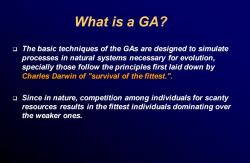
What is a GA? The basic techniques of the GAs are designed to simulate processes in natural systems necessary for evolution, specially those follow the principles first laid down by Charles Darwin of "survival of the fittest." Since in nature,competition among individuals for scanty resources results in the fittest individuals dominating over the weaker ones
What is a GA? ❑ The basic techniques of the GAs are designed to simulate processes in natural systems necessary for evolution, specially those follow the principles first laid down by Charles Darwin of "survival of the fittest.". ❑ Since in nature, competition among individuals for scanty resources results in the fittest individuals dominating over the weaker ones

Evolutionary Algorithms Genetic Evolution Programmind Strategies Genetic Algorithms Classifier Evolutionary Systems Programming genetic representation of candidate solutions ·genetic operators ·selection scheme ·problem domain
Evolutionary Algorithms Genetic Programming Evolution Strategies Genetic Algorithms Evolutionary Programming Classifier Systems • genetic representation of candidate solutions • genetic operators • selection scheme • problem domain

History of GAs ▣ Genetic Algorithms were invented to mimic some of the processes observed in natural evolution.Many people, biologists included,are astonished that life at the level of complexity that we observe could have evolved in the relatively short time suggested by the fossil record. ▣ The idea with GA is to use this power of evolution to solve optimization problems.The father of the original Genetic Algorithm was John Holland who invented it in the early 1970's
History of GAs ❑ Genetic Algorithms were invented to mimic some of the processes observed in natural evolution. Many people, biologists included, are astonished that life at the level of complexity that we observe could have evolved in the relatively short time suggested by the fossil record. ❑ The idea with GA is to use this power of evolution to solve optimization problems. The father of the original Genetic Algorithm was John Holland who invented it in the early 1970's

Classes of Search Techniques Search techniques Calculus-based techniques Guided random search techniques Enumerative techniques Direct methods Indirect methods Evolutionary algorithms Simulated annealing Dynamic programming DFS,BFS Finonacci Newton Evolutionary strategies Genetic algorithms Tabu Search Hill Climbing Genetic Programming Parallel Sequential Centralized Distributed Steady-state Generational
Classes of Search Techniques Finonacci Newton Direct methods Indirect methods Calculus-based techniques Evolutionary strategies Centralized Distributed Parallel Steady-state Generational Sequential Genetic algorithms Evolutionary algorithms Simulated annealing Guided random search techniques Dynamic programming Enumerative techniques Search techniques Tabu Search Hill Climbing DFS, BFS Genetic Programming
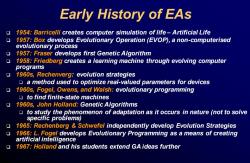
Early History of EAs 1954:Barricelli creates computer simulation of life-Artificial Life 1957:Box develops Evolutionary Operation(EVOP),a non-computerised evolutionary process 1957:Fraser develops first Genetic Algorithm 1958:Friedberg creates a learning machine through evolving computer programs 1960s,Rechenverg:evolution strategies a method used to optimize real-valued parameters for devices 1960s,Fogel,Owens,and Walsh:evolutionary programming to find finite-state machines 1960s,John Holland:Genetic Algorithms to study the phenomenon of adaptation as it occurs in nature(not to solve specific problems) 1965:Rechenberg Schwefel independently develop Evolution Strategies 1966:L.Fogel develops Evolutionary Programming as a means of creating artificial intelligence 1967:Holland and his students extend GA ideas further
Early History of EAs ❑ 1954: Barricelli creates computer simulation of life – Artificial Life ❑ 1957: Box develops Evolutionary Operation (EVOP), a non-computerised evolutionary process ❑ 1957: Fraser develops first Genetic Algorithm ❑ 1958: Friedberg creates a learning machine through evolving computer programs ❑ 1960s, Rechenverg: evolution strategies ❑ a method used to optimize real-valued parameters for devices ❑ 1960s, Fogel, Owens, and Walsh: evolutionary programming ❑ to find finite-state machines ❑ 1960s, John Holland: Genetic Algorithms ❑ to study the phenomenon of adaptation as it occurs in nature (not to solve specific problems) ❑ 1965: Rechenberg & Schwefel independently develop Evolution Strategies ❑ 1966: L. Fogel develops Evolutionary Programming as a means of creating artificial intelligence ❑ 1967: Holland and his students extend GA ideas further
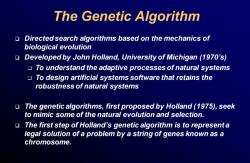
The Genetic Algorithm Directed search algorithms based on the mechanics of biological evolution Developed by John Holland,University of Michigan (1970's) To understand the adaptive processes of natural systems ▣ To design artificial systems software that retains the robustness of natural systems The genetic algorithms,first proposed by Holland(1975),seek to mimic some of the natural evolution and selection. The first step of Holland's genetic algorithm is to representa legal solution of a problem by a string of genes known as a chromosome
The Genetic Algorithm ❑ Directed search algorithms based on the mechanics of biological evolution ❑ Developed by John Holland, University of Michigan (1970’s) ❑ To understand the adaptive processes of natural systems ❑ To design artificial systems software that retains the robustness of natural systems ❑ The genetic algorithms, first proposed by Holland (1975), seek to mimic some of the natural evolution and selection. ❑ The first step of Holland’s genetic algorithm is to represent a legal solution of a problem by a string of genes known as a chromosome
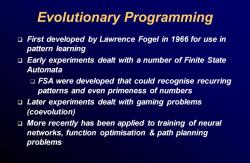
Evolutionary Programming First developed by Lawrence Fogel in 1966 for use in pattern learning Early experiments dealt with a number of Finite State Automata FSA were developed that could recognise recurring patterns and even primeness of numbers ▣ Later experiments dealt with gaming problems (coevolution) More recently has been applied to training of neural networks,function optimisation path planning problems
Evolutionary Programming ❑ First developed by Lawrence Fogel in 1966 for use in pattern learning ❑ Early experiments dealt with a number of Finite State Automata ❑ FSA were developed that could recognise recurring patterns and even primeness of numbers ❑ Later experiments dealt with gaming problems (coevolution) ❑ More recently has been applied to training of neural networks, function optimisation & path planning problems
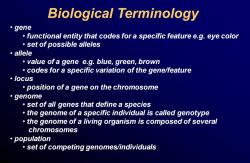
Biological Terminology ·gene functional entity that codes for a specific feature e.g.eye color set of possible alleles ·allele value of a gene e.g.blue,green,brown codes for a specific variation of the gene/feature ·locus position of a gene on the chromosome ·genome set of all genes that define a species the genome of a specific individual is called genotype the genome of a living organism is composed of several chromosomes ·population set of competing genomes/individuals
Biological Terminology • gene • functional entity that codes for a specific feature e.g. eye color • set of possible alleles • allele • value of a gene e.g. blue, green, brown • codes for a specific variation of the gene/feature • locus • position of a gene on the chromosome • genome • set of all genes that define a species • the genome of a specific individual is called genotype • the genome of a living organism is composed of several chromosomes • population • set of competing genomes/individuals
按次数下载不扣除下载券;
注册用户24小时内重复下载只扣除一次;
顺序:VIP每日次数-->可用次数-->下载券;
- 西安电子科技大学:《神经网络与模糊系统 Neural Networks and Fuzzy Systems》课程教学资源(学科综述)模糊系统与模糊逻辑 Fuzzy Theory.ppt
- 西安电子科技大学:《神经网络与模糊系统 Neural Networks and Fuzzy Systems》课程教学资源(学科综述)模糊神经网络 Neuro-fuzzy Systems.ppt
- 西安电子科技大学:《神经网络与模糊系统 Neural Networks and Fuzzy Systems》课程教学资源(学科综述)人工神经网络 Artificial Neural Networks.ppt
- 西安电子科技大学:《神经网络与模糊系统 Neural Networks and Fuzzy Systems》课程教学资源(学科综述)有关人工智能的故事.doc
- 西安电子科技大学:《神经网络与模糊系统 Neural Networks and Fuzzy Systems》课程教学资源(学科综述)人工智能 AI.ppt
- 烟台理工学院:《机器人操作系统》课程教学资源(PPT课件讲稿)第1章 用于机器人的Ubuntu linux.ppt
- 烟台理工学院:《机器人学》课程教学资源(课件讲稿)第四章 机器人的逆向运动学.pdf
- 烟台理工学院:《机器人学》课程教学资源(课件讲稿)第六章 机器人的动力学.pdf
- 烟台理工学院:《机器人学》课程教学资源(课件讲稿)第五章 速度和静态力.pdf
- 烟台理工学院:《机器人学》课程教学资源(课件讲稿)第二章 空间描述和变换.pdf
- 烟台理工学院:《机器人学》课程教学资源(课件讲稿)第九章 机器人的线性控制.pdf
- 烟台理工学院:《机器人学》课程教学资源(课件讲稿)第三章 机器人的顺向运动学.pdf
- 烟台理工学院:《机器人操作系统》课程教学资源(PPT课件讲稿)第3章 机器人编程的Python基础知识.ppt
- 烟台理工学院:《机器人操作系统》课程教学资源(PPT课件讲稿)第2章 机器人编程的C++基础知识.ppt
- 烟台理工学院:《机器人学》课程教学资源(课件讲稿)第一章 机器人概述(主讲:杨智勇).pdf
- 烟台理工学院:《机器人操作系统》课程教学资源(PPT课件讲稿)绪论、第1章 极限与配合及检测.ppt
- 烟台理工学院:《机器人工程专业导论》理论课教学大纲 Introduction to robot engineering.doc
- 烟台理工学院:《竞赛机器人综合实训》课程教学大纲 Comprehensive training of competition robot.doc
- 烟台理工学院:《机器人组装与调试实习》课程教学大纲 Robot assembly and debugging practice.doc
- 烟台理工学院:《机器人建模与仿真》课程教学大纲 Robot Modeling and Simulation.doc
- 《神经网络与模糊系统》课程教学资源(主题演讲)机器学习研究进展(南京大学:王珏).ppt
- 《神经网络与模糊系统》课程教学资源(主题演讲)选择性集成 Selective Ensemble(南京大学:周志华).ppt
- 西安电子科技大学:《神经网络与模糊系统 Neural Networks and Fuzzy Systems》课程PPT课件讲稿(2003)01.Neuronal Dynamics——Activations and Signals(主讲:高新波).ppt
- 西安电子科技大学:《神经网络与模糊系统 Neural Networks and Fuzzy Systems》课程PPT课件讲稿(2003)02. Neuronal Dynamics——Activation Models(1/2).ppt
- 西安电子科技大学:《神经网络与模糊系统 Neural Networks and Fuzzy Systems》课程PPT课件讲稿(2003)02. Neuronal Dynamics——Activation Models(2/2).ppt
- 西安电子科技大学:《神经网络与模糊系统 Neural Networks and Fuzzy Systems》课程PPT课件讲稿(2003)03. 突触动力学 - 非监督学习 Synaptic Dynamics I——Unsupervised Learning(1/2).ppt
- 西安电子科技大学:《神经网络与模糊系统 Neural Networks and Fuzzy Systems》课程PPT课件讲稿(2003)03. 突触动力学 - 非监督学习 Synaptic Dynamics I——Unsupervised Learning(2/2).ppt
- 西安电子科技大学:《神经网络与模糊系统 Neural Networks and Fuzzy Systems》课程PPT课件讲稿(2003)04. 突触动力学Ⅱ:有监督学习 Synaptic Dynamics II——Supervised Learning(2/2).ppt
- 西安电子科技大学:《神经网络与模糊系统 Neural Networks and Fuzzy Systems》课程PPT课件讲稿(2003)05. 结构和平衡 Architectures and Equilibria.ppt
- 西安电子科技大学:《神经网络与模糊系统 Neural Networks and Fuzzy Systems》课程PPT课件讲稿(2003)06. 模糊与概率 Fuzziness versus Probability.ppt
- 西安电子科技大学:《神经网络与模糊系统 Neural Networks and Fuzzy Systems》课程PPT课件讲稿(2003)07. 模糊联想记忆 Fuzzy Associative Memories(FAM).ppt
- 西安电子科技大学:《神经网络与模糊系统 Neural Networks and Fuzzy Systems》课程PPT课件讲稿(2003)08. 模糊与神经网络的比较——以倒车系统为例 Comparison of Fuzzy and Neural Truck Backer-Upper Control Systems.ppt
- 西安电子科技大学:《神经网络与模糊系统 Neural Networks and Fuzzy Systems》课程PPT课件讲稿(2003)09. 模糊图像变换编码 Fuzzy Image Transform Coding.ppt
- 西安电子科技大学:《神经网络与模糊系统 Neural Networks and Fuzzy Systems》课程PPT课件讲稿(2003)10. 模糊与卡尔曼滤波目标跟踪控制系统的比较 Comparison of Fuzzy and Kalman-Filter Target-Tracking Control Systems.ppt
- 西安电子科技大学:《神经网络与模糊系统 Neural Networks and Fuzzy Systems》课程PPT课件讲稿(2004)Chapter 02 ACTIVATIONS AND SIGNALS.ppt
- 西安电子科技大学:《神经网络与模糊系统 Neural Networks and Fuzzy Systems》课程PPT课件讲稿(2004)Chapter 03 Neuronal Dynamics 2:Activation Models.ppt
- 西安电子科技大学:《神经网络与模糊系统 Neural Networks and Fuzzy Systems》课程PPT课件讲稿(2004)Chapter 04 SYNAPTIC DYNAMICS 1:UNSUPERVISED LEARNING.ppt
- 西安电子科技大学:《神经网络与模糊系统 Neural Networks and Fuzzy Systems》课程PPT课件讲稿(2004)Chapter 05-1 第五章 突触动力学Ⅱ:有监督学习.ppt
- 西安电子科技大学:《神经网络与模糊系统 Neural Networks and Fuzzy Systems》课程PPT课件讲稿(2004)Chapter 05-2 Synaptic DynamicsII:Supervised Learning.ppt
- 西安电子科技大学:《神经网络与模糊系统 Neural Networks and Fuzzy Systems》课程PPT课件讲稿(2004)Chapter 06 Architecture and Equilibra 结构和平衡.ppt
